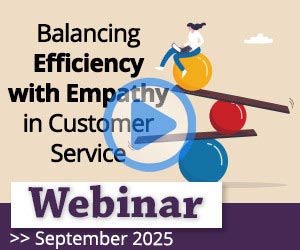When agents fail to practice patience, things can go downhill fast! Misunderstandings happen and people get angry. One bad call can even damage your brand’s reputation!
So really, it’s imperative that your agents can keep a cool head, while also protecting their own mental health, for the greatest good of the company.
That’s why we’ve pulled together these practical techniques and training exercises to help your agents respond well under pressure, alongside top tips on how to remove common barriers that can make practicing patience near impossible.
10 Ways to Practice Patience in Customer Service
Agents need both in-the-moment strategies and long-term training techniques to master patience. Here are some effective methods you can try:
1. Having a Go-To Mantra
Repeating a simple affirmation (e.g., “Stay calm, stay professional”) can help agents regain composure in tough interactions.
You could even set this as a screensaver or put posters around the contact centre as a helpful visual reminder.
2. Using the Mute Button Strategically
If needed, briefly muting the line can give agents a moment to collect themselves without the customer noticing.
3. Visualizing Success
Before engaging with a challenging customer, encourage agents to picture a positive outcome to set the right mindset.
4. Pausing Before Responding
A short pause prevents knee-jerk reactions and allows for a thoughtful, measured reply.
5. Taking Deep Breaths
A simple exercise (e.g., inhale for four seconds, hold for four, exhale for four, for example) can defuse the immediate stress of the situation and refocus the mind.
6. Using Empathetic Phrasing
Phrases like “I completely understand why this is frustrating for you” help de-escalate tension and foster connection.
If you are looking for more empathy statements that can be used in customer conversations, read our article: Empathy Statements for Customer Service With Examples
7. Practicing Active Listening
Fully concentrate on what the customer is saying without interrupting. Repeat key points to confirm understanding.
8. Keeping a Neutral Tone
Even in tense situations, maintaining a calm, steady voice can prevent the situation from escalating.
For advice on the impact of tone of voice in customer interactions, read our article: How to Utilize Tone of Voice in the Contact Centre
9. Reframing the Interaction
Encourage your agents to reframe interactions that test their patience.
For example, instead of viewing a difficult customer as a problem, see them as an opportunity or even a fun challenge to turn the situation around.
10. Asking for Help
If frustration builds up, agents should feel empowered to escalate the call or consult a supervisor for guidance.
Agent Training Exercises for Practicing Patience
Have you ever thought about training your agents through role-play?
Here are three of our favourite ways to help boost your agents’ patience, by helping them test out their strategies in a friendly environment.
Training Exercise 1: The “Worst Customer Ever” Challenge
The “Worst Customer Ever” Challenge is a valuable training exercise that prepares customer service agents for difficult interactions.
Agents create an exaggerated, extreme customer persona – someone overly demanding, rude, or unreasonable – designed to push every button. They then brainstorm strategies for professionally defusing the situation.
Role-playing these extreme scenarios allows agents to practice patience, empathy, and de-escalation techniques in a safe environment.
This challenge helps them develop on-the-spot thinking, build a repertoire of responses for challenging situations, and increase confidence in handling high-stress interactions.
With these “worst-case” scenarios at the ready, agents learn transferable skills applicable to real-world customer interactions, making them more adaptable and prepared for any situation.
Training Exercise 2: The “Patience Under Pressure” Drill
In this drill, an agent is put into a simulated scenario where the customer repeatedly interrupts or talks over them.
The goal is for the agent to maintain patience, stay focused, and still find ways to effectively manage the conversation.
This can involve using techniques like calmly saying, “I understand you’re frustrated, and I want to make sure I fully address your concerns. Can I finish explaining and then we can go through everything you need?”
Through this exercise, agents learn how to redirect the conversation, assert control in a polite and professional manner, and remain calm, no matter how challenging the customer becomes.
Practicing patience in this way and envisioning the absolute worst-case scenario builds emotional resilience and gives agents the tools to stay composed if and when similar, real-world situations come to pass.
Training Exercise 3: The “Escalation Ladder” Exercise
The Escalation Ladder Exercise is a training tool to help customer service agents develop patience in progressively challenging scenarios.
In this exercise, agents are presented with a series of escalating customer frustrations (let’s give them a rating of 1–5, too).
The first stage might involve a mildly annoyed customer, while later stages introduce more intense complaints, rudeness, or even aggression – while the fifth stage would be intense, nuclear levels from the customer (see the “worst customer ever” exercise above).
The goal in this exercise is for agents to determine the best approach in the situation. It encourages agents to adjust their responses based on the customer’s tone and behaviour, rather than simply reacting.
This helps them build confidence in handling high-stress situations, teaches the importance of remaining calm under pressure, and enables them to identify when a situation requires de-escalation techniques, or another approach.
For more great training exercises you can use in your call centre to improve agent performance, read our article: How to Use Mock Calls to Improve Agent Performance – With Free Exercises
Printable – 3 Agent Training Exercises for Practicing Patience
Do you want to download this to share with your team?
Get your free download of 3 Agent Training Exercises for Practicing Patience now:
Barriers to Patience and How to Remove Them
Even the most patient folks have their limits – especially when they feel compromised by awful systems and frustrating processes.
So, also be sure to fix these underlying problems too, as it’ll be far easier for agents to keep their cool when there’s nothing else getting in their way.
Do these issues need fixing in your contact centre?
Inefficient Processes
The Problem
Slow systems, unclear policies, and outdated tools can frustrate agents and make customers impatient too.
The Solution
Streamline your workflows, invest in better software, and provide clear guidelines to empower agents to resolve issues efficiently.
To find out what the experts think are the classic broken processes to look out for and signs to spot them, read our article: Key Signs of Broken Processes (and How to Fix Them)
High Workload & Burnout
The Problem
Overworked agents have less emotional bandwidth, making it harder to exercise patience.
The Solution
Implement fair scheduling, offer adequate breaks, and promote wellness programmes to prevent burnout.
For top tips and advice on reducing absence, agent burnout, and attrition, read our article: Tackle the 3 A’s – Absence, Agent Burnout, and Attrition
Lack of Regular Training
The Problem
Agents who don’t know how to handle difficult customers are more likely to lose patience.
The Solution
Regular training sessions and real-world simulations can equip them with tools to stay composed under pressure. It should never be a “one and done” exercise.
Unrealistic Customer Expectations
The Problem
Customers who expect instant solutions can test an agent’s patience.
The Solution
Set clear expectations at the beginning of interactions and offer proactive solutions to manage demand. This will help to keep every conversation as positive as possible and set everyone up for success.
If you are looking for information on how to set customer expectations during a call, read our article: How to Set the Right Expectations on a Call
Negative Work Environment
The Problem
A toxic or unsupportive workplace makes it harder for agents to maintain a positive, patient demeanour.
The Solution
Foster a supportive culture with strong leadership, peer recognition, and stress management resources. Also be sure to nurture psychological safety.
For advice to help you to understand the different types of toxicity and give you some actionable steps, read our article: How to Identify and Manage Toxic Employees
Help Your Agents Use These Techniques Today
Achieving a patient customer service environment requires a mixture of quick fixes and long-term work.
You can tackle common problems right away, then build on that with structured training programmes to really develop those skills.
So, why not start helping your agents use these techniques today and see the difference they can make?
If you are looking for more information and advice on improving your customer service interactions, read these articles next:
- The 5-Star Customer Service Skills Your Team Really Need
- 5 Soft Skills Every Agent Needs Before Taking Their First Call
- How to Develop Empathy as a Skill in Your Frontline Teams
Author: Stephanie Lennox
Reviewed by: Megan Jones
Published On: 11th Jun 2025 - Last modified: 14th Aug 2025
Read more about - Skills, Call Handling, Editor's Picks, Empowering Agents, Free Downloads, Skill Development, Soft Skills, Stephanie Lennox, Top Story, Training and Coaching







































